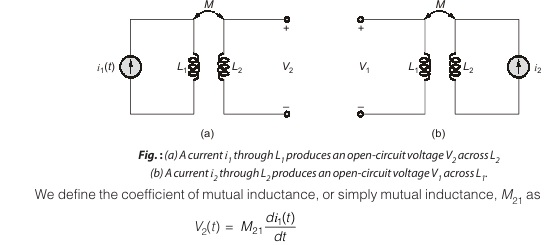MUTUAL INDUCTANCE
When we defined inductance, we did so by specifying the relationship between the terminal voltage and current,
The physical basis for such a current-voltage characteristic rests upon two things:
- The production of a magnetic flux by a current, the flux being proportional to the current in linear inductors.
- The production of a voltage by the time-varying magnetic field, the voltage being proportional to the time rate of change of the magnetic field or the magnetic flux.
Coefficient of Mutual Inductance
Mutual inductance results from a slight extension of this same argument. A current flowing in one coil
establishes a magnetic flux about that coil and also about a second coil nearby. The time-varying flux surrounding
the second coil produces a voltage across the terminals of the second coil. This voltage is proportional to the
time rate of change of the current flowing through the first coil. Figure shows a simple model of two coils L1 and
L2, sufficiently close together that the flux produced by a current i1(t) flowing through L1 establishes an open
circuit voltage V2(t) across the terminals of L2.

The order of the subscripts on M21 indicates that a voltage response is produced at L2 by a current source at L1. If the system is reversed, as indicted in fig. then we have
Two coefficients of mutual inductance are not necessary, however we will use energy relationship a little later to prove that M12 and M21 are equal. This M12 = M21 = M.
The existence of mutual coupling between two coils is indicated by a double-headed arrow, as shown in figure (a) and (b).
Note: It is important to know that mutual coupling exist only when the inductors are placed close to each other and input excitation is time varying.


